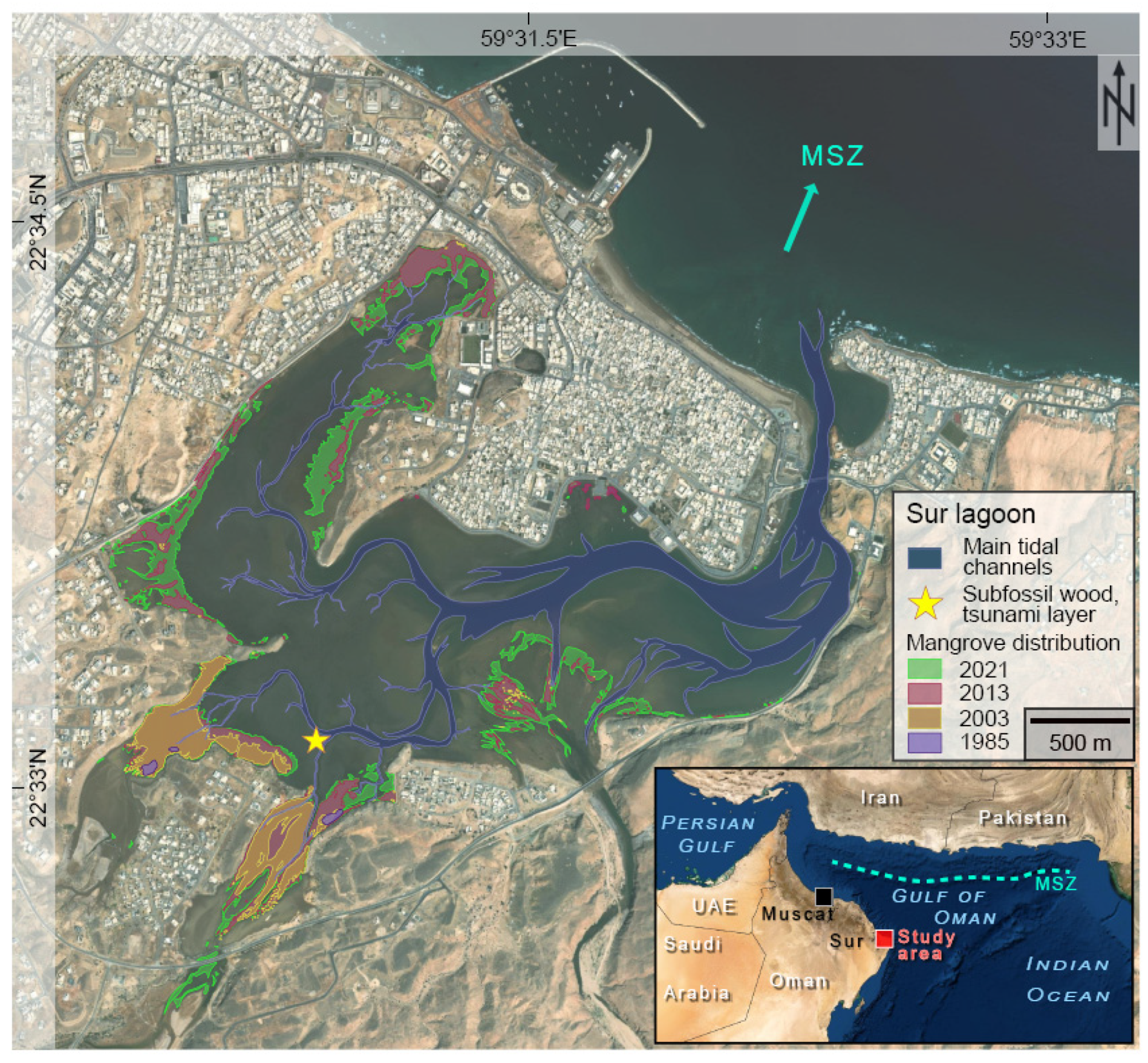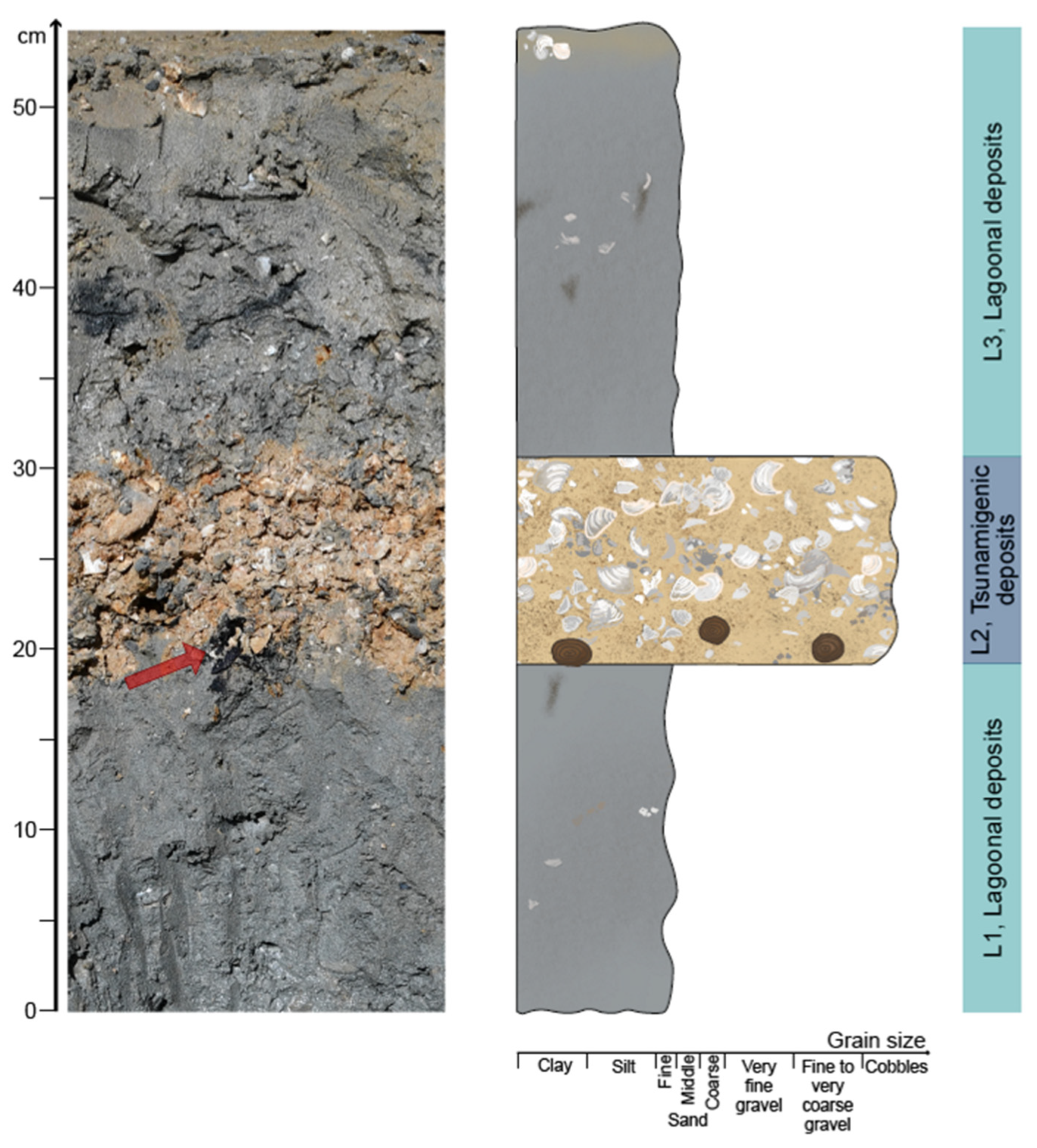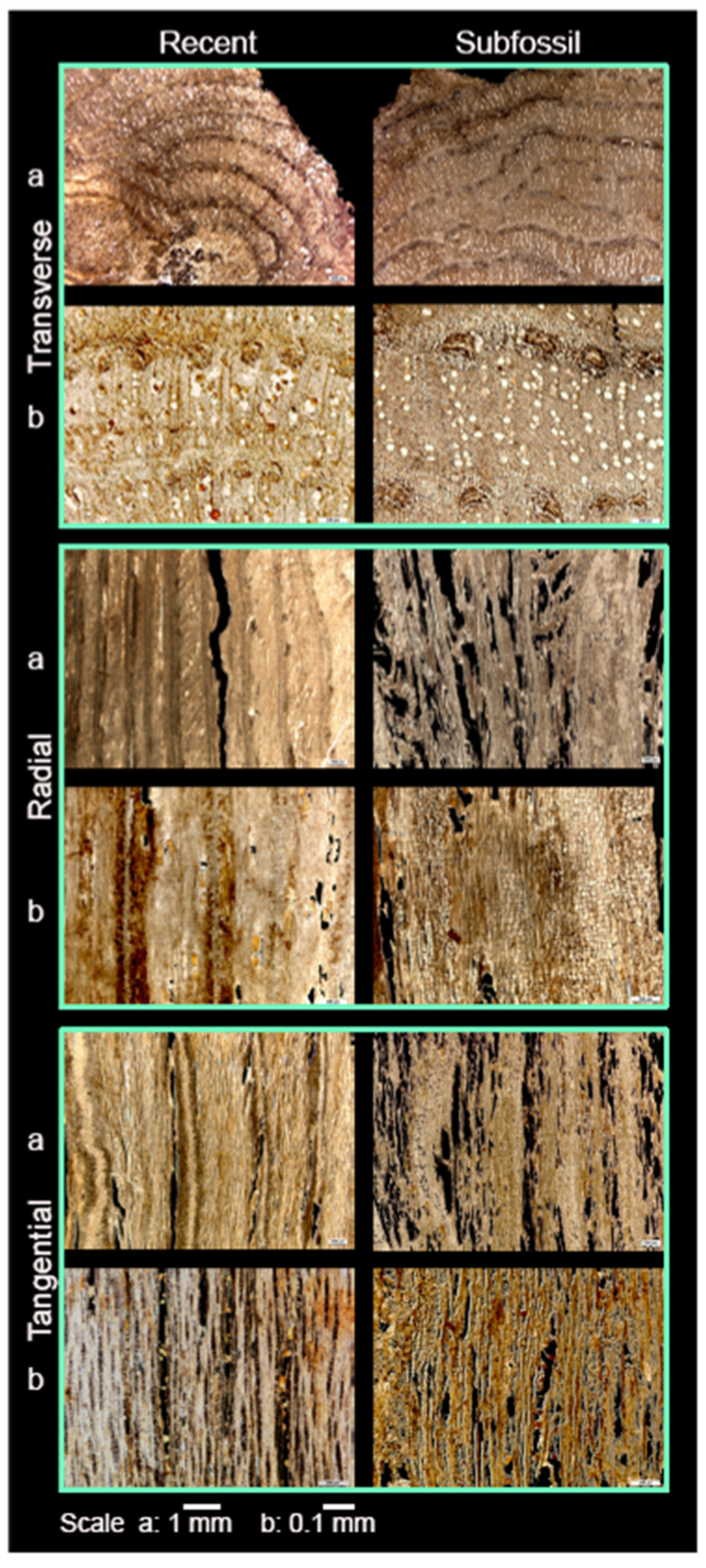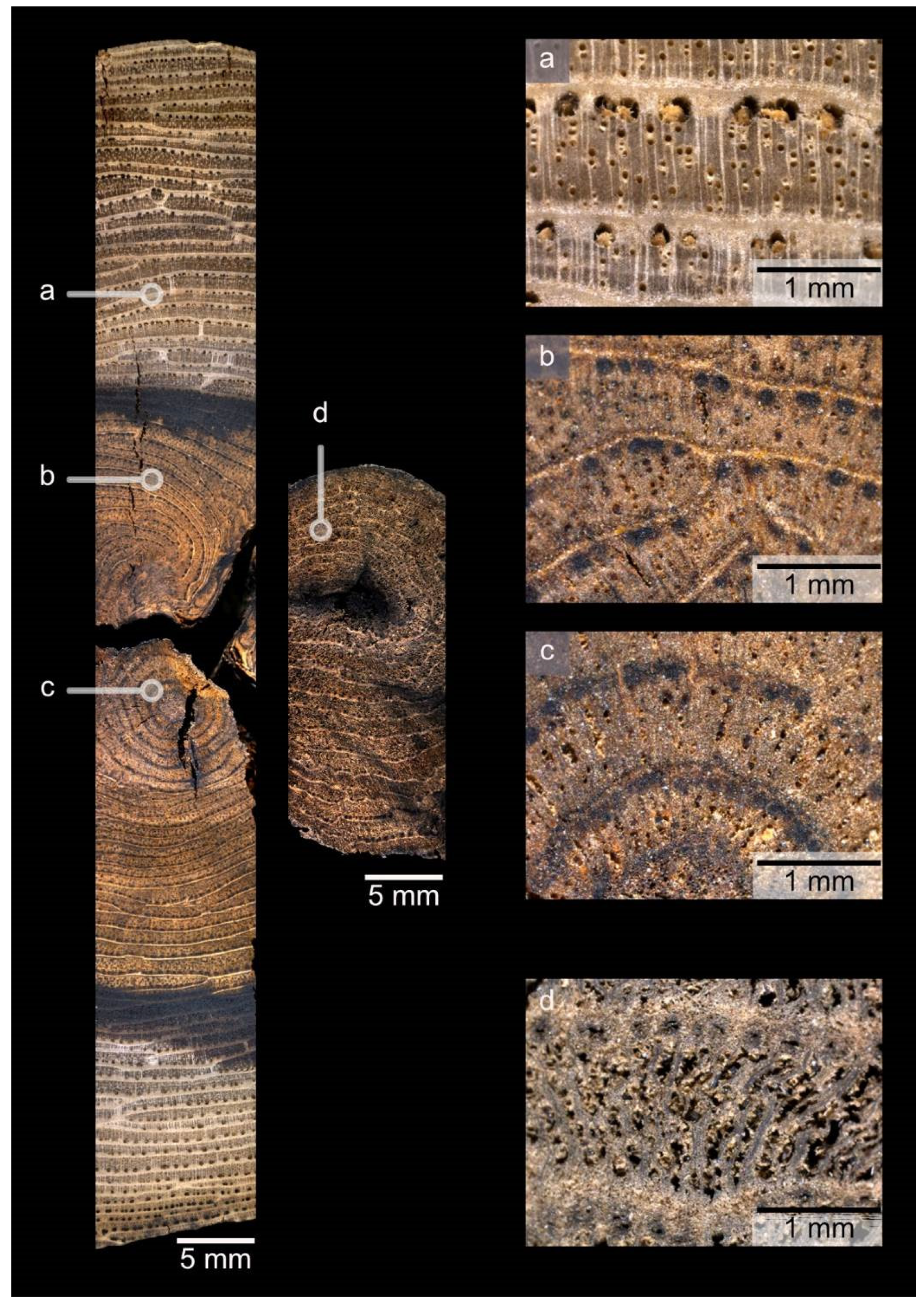Life on the Edge: A Powerful Tsunami Overwhelmed Indian Ocean Mangroves One Millennium Ago
Abstract
:1. Introduction
2. Materials and Methods
2.1. Fieldwork
2.2. Wood Preparation
2.3. Age Dating
3. Results
3.1. Measured Section at SW Sur Lagoon
3.2. Age Dating
3.3. Additional Observations
3.4. Identification of the Trench Wood
4. Discussion
5. Conclusions
Supplementary Materials
Author Contributions
Funding
Data Availability Statement
Acknowledgments
Conflicts of Interest
References
- Costa, P.J.; Andrade, C. Tsunami deposits: Present knowledge and future challenges. Sedimentology 2020, 67, 1189–1206. [Google Scholar] [CrossRef]
- Løvholt, F.; Setiadi, N.J.; Birkmann, J.; Harbitz, C.B.; Bach, C.; Fernando, N.; Kaiser, G.; Nadim, F. Tsunami risk reduction—Are we better prepared today than in 2014. IJDRR 2014, 10, 127–142. [Google Scholar]
- Tanaka, N.; Sasaki, Y.; Mowjood, M.I.M.; Jinadasa, K.B.S.N.; Homchuen, S. Coastal vegetation structures and their functions in tsunami protection: Experience of the recent Indian Ocean tsunami. Landsc. Ecol. Eng. 2007, 3, 33–45. [Google Scholar] [CrossRef]
- Alongi, D.M. Mangrove forests: Resilience, protection from tsunamis, and responses to global climate change. Estuar. Coast. Shelf Sci. 2008, 76, 1–13. [Google Scholar] [CrossRef]
- Lee, S.Y.; Primavera, J.H.; Dahdouh-Guebas, F.; McKee, K.; Bosire, J.O.; Cannicci, S.; Diele, K.; Fromard, F.; Koedam, N.; Marchand, C.; et al. Ecological role and services of tropical mangrove ecosystems: A reassessment. Glob. Ecol. Biogeogr. 2014, 23, 726–743. [Google Scholar] [CrossRef]
- Barbier, E.B. Natural barriers to natural disasters: Replanting mangroves after the tsunami. Front. Ecol. Environ. 2006, 4, 124–131. [Google Scholar] [CrossRef]
- Minoura, K.; Imamura, F.; Sugawara, D.; Kono, Y.; Iwashita, T. The 869 Jogan tsunami deposit and recurrence interval of large-scale tsunami on the Pacific coast of northeast Japan. J. Nat. Disaster Sci. 2001, 23, 83–88. [Google Scholar]
- Barnes, G.L. The search for tsunami evidence in the geological and archaeological records, with a focus on Japan. Asian Perspect. 2017, 56, 132–165. [Google Scholar] [CrossRef] [Green Version]
- Byrne, D.E.; Sykes, L.R.; Davis, D.M. Great thrust earthquakes and aseismic slip along the plate boundary of the Makran subduction zone. J. Geophys. Res. Solid Earth 1992, 97, 449–478. [Google Scholar] [CrossRef]
- DeMets, C.; Gordon, R.G.; Donald, F.A. Geologically current plate motions. Geophys. J. Int. 2010, 181, 1–80. [Google Scholar] [CrossRef] [Green Version]
- Smith, G.L.; McNeill, L.C.; Wang, K.; He, J.; Henstock, T.J. Thermal structure and megathrust seismogenic potential of the Makran subduction zone. Geophys. Res. Lett. 2013, 40, 1528–1533. [Google Scholar] [CrossRef] [Green Version]
- Kopp, C.; Fruehn, J.; Flueh, E.R.; Reichert, C.; Kukowski, N.; Bialas, J.; Klaeschen, D. Structure of the Makran subduction zone from wide-angle and reflection seismic data. Tectonophysics 2000, 329, 171–191. [Google Scholar] [CrossRef]
- Hoffmann, G.; Al-Yahyai, S.; Naeem, G.; Kociok, M.; Grützner, C. An Indian Ocean tsunami triggered remotely by an onshore earthquake in Balochistan. Geology 2014, 42, 883–886. [Google Scholar] [CrossRef]
- Kakar, D.M.; Naeem, G.; Usman, A.; Hasan, H.; Lohdi, H.A.; Srinivasalu, S.; Andrade, V.; Rajendran, C.P.; Beni, A.N.; Hamzeh, M.A.; et al. Elders recall an earlier tsunami on Indian Ocean shores. Eos Trans. Am. Geophys. Union 2014, 95, 485–486. [Google Scholar] [CrossRef] [Green Version]
- Donato, S.V.; Reinhardt, E.G.; Boyce, J.I.; Rothaus, R.; Vosmer, T. Identifying tsunami deposits using bivalve shell taphonomy. Geology 2008, 36, 199–202. [Google Scholar] [CrossRef]
- Lézine, A.M.; Saliège, J.F.; Mathieu, R.; Tagliatela, T.L.; Mery, S.; Charpentier, V.; Cleuziou, S. Mangroves of Oman during the late Holocene; climatic implications and impact on human settlements. Veg. Hist. Archaeobot. 2002, 11, 221–232. [Google Scholar] [CrossRef]
- Decker, V.; Falkenroth, M.; Lindauer, S.; Landgraf, J.; Al-Lawati, Z.; Al-Rahbi, H.; Franz, S.O.; Hoffmann, G. Collapse of Holocene mangrove ecosystems along the coastline of Oman. Quat. Res. 2021, 100, 52–76. [Google Scholar] [CrossRef]
- Lézine, A.M.; Ivory, S.J.; Braconnot, P.; Marti, O. Timing of the southward retreat of the ITCZ at the end of the Holocene Humid Period in Southern Arabia: Data-model comparison. Quat. Sci. Rev. 2017, 164, 68–76. [Google Scholar] [CrossRef]
- Deckers, K.; Döpper, S.; Schmidt, C. Vegetation, land, and wood use at the sites of Bat and Al-Khashbah in Oman (fourth–third millennium BC). Arab Arch Epig. 2019, 30, 1–14. [Google Scholar] [CrossRef]
- Tengberg, M. Les forêts de la mer. Exploitation et évolution des mangroves en Arabie orientale du Néolithique à l’époque islamique. Paléorient 2005, 31, 39–45. [Google Scholar] [CrossRef]
- Cleuziou, S.; Tosi, M. The great transformation. In In the Shadow of the Ancestors; Cleuziou, S., Tosi, M., Eds.; Al Nahda Printing Press: Muscat, Oman, 2007; pp. 61–97. [Google Scholar]
- Robert, E.M.; Koedam, N.; Beeckman, H.; Schmitz, N. A safe hydraulic architecture as wood anatomical explanation for the difference in distribution of the mangroves Avicennia and Rhizophora. Funct. Ecol. 2009, 23, 649–657. [Google Scholar] [CrossRef]
- De Deurwaerder, H. How are Anatomical and Hydraulic Features of Avicennia marina and Rhizophora mucronata Trees Influenced by Siltation? Master’s Thesis, University of Ghent, Brussels, Belgium, 2012. [Google Scholar]
- Tomlinson, P.B. The Botany of Mangroves, 2nd ed.; Cambridge University Press: New York, NY, USA, 2016; p. 432. [Google Scholar]
- Milani, A.S. Mangrove forests of the Persian Gulf and the Gulf of Oman. In Threats to Mangrove Forests: Hazards, Vulnerability, and Risk Management; Makowski, C., Finkl, C.W., Eds.; Springer: Cham, Germany, 2018; pp. 53–75. [Google Scholar]
- Le Roux, J.P.; Vargas, G. Hydraulic behavior of tsunami backflows: Insights from their modern and ancient deposits. Environ. Geol. 2005, 49, 65. [Google Scholar] [CrossRef]
- Dawson, A.G.; Stewart, I. Tsunami deposits in the geological record. Sediment. Geol. 2007, 200, 166–183. [Google Scholar] [CrossRef]
- Rhodes, B.P.; Kirby, M.E.; Jankaew, K.; Choowong, M. Evidence for a mid-Holocene tsunami deposit along the Andaman coast of Thailand preserved in a mangrove environment. Mar. Geol. 2011, 282, 255–267. [Google Scholar] [CrossRef]
- Pilarczyk, J.E.; Reinhardt, E.G.; Boyce, J.I.; Schwarcz, H.P.; Donato, S.V. Assessing surficial foraminiferal distributions as an overwash indicator in Sur Lagoon, Sultanate of Oman. Mar. Micropaleontol. 2011, 80, 62–73. [Google Scholar] [CrossRef]
- Riedelsheimer, B.; Büchl-Zimmermann, S.; Welsch, U. Schnittpräparation für die Lichtmikroskopie. In Romeis—Mikroskopische Technik, 19th ed.; Mulisch, M., Welsch, U., Eds.; Springer: Berlin/Heidelberg, Germany, 2015; pp. 99–120. [Google Scholar]
- Jagiella, C.; Kürschner, H. Atlas der Hölzer Saudi Arabiens. Die Holzanatomie der Wichtigsten Bäume und Sträucher Arabiens mit Einem Holzanatomischen Bestimmungsschlüssel; Beihefte zum TAVO; Ludwig Reichert: Wiesbaden, Germany, 1987; Volume 20, p. 176. [Google Scholar]
- Reimer, P.J.; Bard, E.; Bayliss, A.; Beck, J.W.; Blackwell, P.G.; Ramsey, C.B.; Buck, C.E.; Buck, C.E.; Cheng, H.; Edwards, R.L.; et al. IntCal13 and Marine13 Radiocarbon Age Calibration Curves 0–50,000 Years cal BP. Radiocarbon 2013, 55, 1869–1887. [Google Scholar] [CrossRef] [Green Version]
- Schmitz, N.; Verheyden, A.; Kairo, J.G.; Beeckman, H.; Koedam, N. Successive cambia development in Avicennia marina (Forskk.) Vierh. is not climatically driven in the seasonal climate at Gazi Bay, Kenya. Dendrochronologia 2007, 25, 87–96. [Google Scholar] [CrossRef] [Green Version]
- Ambraseys, N.N.; Melville, C.P. A History of Persian Earthquakes; Cambridge University Press: Cambridge, UK, 1982; p. 219. [Google Scholar]
- Prizomwala, S.P.; Gandhi, D.; Bhatt, N.; Winkler, W.; Kumar, M.R.; Makwana, N.; Bhatt, N. Geological evidence for AD 1008 tsunami along the Kachchh coast, Western India: Implications for hazard along the Makran Subduction Zone. Sci. Rep. 2018, 8, 16816. [Google Scholar] [CrossRef] [PubMed]
- Shah-hosseini, M.; Morhange, C.; Beni, A.N.; Marriner, N.; Lahijani, H.; Hamzeh, M.; Sabatier, F. Coastal boulders as evidence for high-energy waves on the Iranian coast of Makran. Mar. Geol. 2011, 290, 17–28. [Google Scholar] [CrossRef]
- Hoffmann, G.; Grützner, C.; Schneider, B.; Preusser, F.; Reicherter, K. Large Holocene tsunamis in the northern Arabian Sea. Mar. Geol. 2020, 419, 106068. [Google Scholar] [CrossRef]
- Maselli, V.; Oppo, D.; Moore, A.L.; Gusman, A.R.; Mtelela, C.; Iacopini, D.; Taviani, M.; Mjema, E.; Mulaya, E.; Che, M.; et al. A 1000-yr-old tsunami in the Indian Ocean points to greater risk for East Africa. Geology 2020, 48, 808–813. [Google Scholar] [CrossRef]
- Donato, S.V.; Reinhardt, E.G.; Boyce, J.I.; Pilarczyk, J.E.; Jupp, B.P. Particle-size distribution of inferred tsunami deposits in Sur Lagoon, Sultanate of Oman. Mar. Geol. 2009, 257, 54–64. [Google Scholar] [CrossRef]
- Bezerra, F.H.R.; Vita-Finzi, C.; Lima-Filho, F.P. The use of marine shells for radiocarbon dating of coastal deposits. Rev. Bras. Geociências 2000, 30, 211–213. [Google Scholar] [CrossRef]
- Culleton, B.J.; Kennett, D.J.; Ingram, B.L.; Erlandson, J.M.; Southon, J.R. Intrashell radiocarbon variability in marine mollusks. Radiocarbon 2006, 48, 387–400. [Google Scholar] [CrossRef] [Green Version]
- Gillespie, R.; Polach, H.A. The suitability of marine shells for radiocarbon dating of Australian prehistory. In Radiocarbon Dating; Berger, R., Suess, H.E., Eds.; University of California Press: Berkeley, CA, USA, 2020; pp. 404–421. [Google Scholar]
- Hoffmann, G.; Rupprechter, M.; Al Balishi, N.; Grützner, C.; Reicherter, K. The impact of the 1945 Makran tsunami along the coastlines of the Arabian Sea (Northern Indian Ocean)—A review. Z. Für Geomorphol. 2013, 57 (Suppl. 4), 257–277. [Google Scholar] [CrossRef]
- Lézine, A.M. Timing of vegetation changes at the end of the Holocene Humid Period in desert areas at the northern edge of the Atlantic and Indian monsoon systems. Comptes Rendus Geosci. 2009, 341, 750–759. [Google Scholar] [CrossRef]
- Cisternas, M.; Atwater, B.F.; Torrejon, F.; Sawai, Y.; Machuca, G.; Lagos, M.; Eipert, A.; Youlton, C.; Salgado, I.; Kamataki, T.; et al. Predecessors of the giant 1960 Chile earthquake. Nature 2005, 437, 404–407. [Google Scholar] [CrossRef]
- Monecke, K.; Finger, W.; Klarer, D.; Kongko, W.; McAdoo, B.G.; Moore, A.L.; Sudrajat, S.U. A 1000-year sediment record of tsunami recurrence in northern Sumatra. Nature 2008, 455, 1232–1234. [Google Scholar] [CrossRef]





Publisher’s Note: MDPI stays neutral with regard to jurisdictional claims in published maps and institutional affiliations. |
© 2022 by the authors. Licensee MDPI, Basel, Switzerland. This article is an open access article distributed under the terms and conditions of the Creative Commons Attribution (CC BY) license (https://creativecommons.org/licenses/by/4.0/).
Share and Cite
Decker, V.; Gee, C.T.; Schucht, P.J.; Lindauer, S.; Hoffmann, G. Life on the Edge: A Powerful Tsunami Overwhelmed Indian Ocean Mangroves One Millennium Ago. Forests 2022, 13, 922. https://doi.org/10.3390/f13060922
Decker V, Gee CT, Schucht PJ, Lindauer S, Hoffmann G. Life on the Edge: A Powerful Tsunami Overwhelmed Indian Ocean Mangroves One Millennium Ago. Forests. 2022; 13(6):922. https://doi.org/10.3390/f13060922
Chicago/Turabian StyleDecker, Valeska, Carole T. Gee, Pia J. Schucht, Susanne Lindauer, and Gösta Hoffmann. 2022. "Life on the Edge: A Powerful Tsunami Overwhelmed Indian Ocean Mangroves One Millennium Ago" Forests 13, no. 6: 922. https://doi.org/10.3390/f13060922






